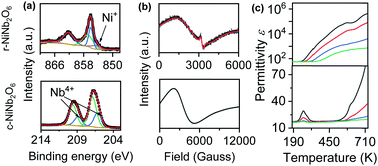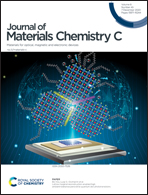Effect of cation arrangement on polaron formation and colossal permittivity in NiNb2O6†
Abstract
Localized polaron hopping is one of the common mechanisms of colossal permittivity in oxides; however, its formation still remains to be explored. In this study, the effect of the cation arrangement on polaron formation and dielectric responses was experimentally revealed in two polymorphs of NiNb2O6, i.e., the ordered columbite (c-NiNb2O6) and the disordered rutile (r-NiNb2O6) phases. Nb4+-type polarons and typical long-range conduction induced dielectric dispersion were observed in c-NiNb2O6, while Ni+-type polarons and colossal permittivity were found in r-NiNb2O6. A broad and temperature-independent (in linewidth) EPR band at g ∼ 1.982 was observed in c-NiNb2O6. In contrast, r-NiNb2O6 exhibited the coexistence of a broad band (g ∼ 2.816), which showed the dipolar broadening effect, and a sharp band (g ∼ 2.076), which was significantly enhanced at T ∼ 580 K. The correlation between EPR band broadening and an increased conductivity was also evidenced. The results suggest the existence of delocalized Nb4+ polarons in ordered c-NiNb2O6, and that the Ni/Nb disordering facilitated the formation of localized Ni+ polaron, which induced colossal permittivity in r-NiNb2O6.



 Please wait while we load your content...
Please wait while we load your content...